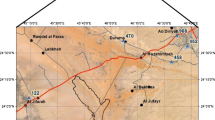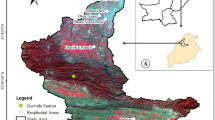Abstract
Rooftop rainwater harvesting, among other options, play a central role in addressing water security and reducing impacts on the environment. The storm or annual storm runoff coefficient (RC/ASRC) play a significant role in quantification of potential of rooftop catchments for rainwater harvesting, however, these are usually selected from generic lists available in literature. This study explores methodology/procedures based on one of the most popular and versatile hydrological model, Soil Conservation Service Curve Number (SCS-CN) (SCS 1986) and its variants, i.e., Hawkins SCS-CN (HSCS-CN) model (Hawkins et al. 2001), Michel SCS-CN (MSCS-CN) model (Michel et al. Water Resour Res 41:W02011, 2005), and Storm Water Management Model-Annual Storm Runoff Coefficient (SWMM-ASRC) (Heaney et al. 1976) and compares their performance with Central Ground Board (CGWB) (CGWB 2000) approach. It has been found that for the same amount of rainfall and same rooftop catchment area, the MSCS-CN model yields highest rooftop runoff followed by SWMM-ASRC > HSCS-CN > SCS-CN > CGWB. However, the SCS-CN model has close resemblance with CGWB approach followed by HSCS-CN model, SWMM-ASRC, and MSCS-CN model. ASRCs were developed using these models and it was found that MSCS-CN model has the highest value of ASRC (= 0.944) followed by SWMM-ASRC approach (=0.900), HSCS-CN model (=0.830), SCS-CN model (=0.801), and CGWB approach (=0.800). The versatility of these models lies to the fact that CN values (according to rooftop catchment characteristics) would yield rooftop runoff and therefore ASRC values based on sound hydrological perception and not just on the empiricism. The models have inherent capability to incorporate the major factors responsible for runoff production from rooftop/urban, i.e., surface characteristics, initial abstraction, and antecedent dry weather period (ADWP) for the catchments and would be better a tool for quantification rather than just using empirical runoff coefficients for the purpose.


Similar content being viewed by others
References
Angrill S, Farreny R, Gasol CM, Gabarrell X, Viñolas B, Josa A, Rieradevall J (2012) Environmental analysis of rainwater harvesting infrastructures in diffuse and compact urban models of Mediterranean climate. Int J Life Cycle Assess 17(1):25–42
ASCE (1969) Design and construction of sanitary storm sewers. In: ASCE manuals and reports on engineering practice, 37. ASCE, New York
Basinger M, Montalto F, Lall U (2010) A rainwater harvesting system reliability model based on nonparametric stochastic rainfall generator. J Hydrology 392:105–118
Central Ground Water Board (2000) Guide on artificial recharge to ground water prepared by central ground water board. Ministry of Water Resources, Government of India, New Delhi
Chiu Y-R, Liaw C-H, Chen L-C (2009) Optimizing rainwater harvesting systems as an innovative approach to saving energy in hilly communities. Renew Energy 34:92–498
Coombes PJ, Kuczera G, Kalma JD, Argue JR (2002) An evaluation of the benefits of source control measures at the regional scale. Urban Water 4:307–320
El-Sayed M, Mahgoub M, van der Steen NP, Abu-Zeid K, Vairavamoorthy K (2010) Towards sustainability in urban water: a life cycle analysis of the urban water system of Alexandria City, Egypt. J Clean Prod 18(10–11):1100–1106
Farreny R, Gabarrell X, Rieradevall J (2011a) Cost-efficiency of rainwater harvesting strategies in dense Mediterranean neighbourhoods. Resour Conserv Recycl 55:686–694
Farreny R, Morales-Pinzón T, Guisasola A, Taya C, Rieradevall J, Gabarrell X (2011b) Roof selection for rainwater harvesting: quantity and quality assessments in Spain. Water Res 45:3245–3254
Fewkes A (2000) Modelling the performance of rainwater collection systems: towards a generalised approach. Urban Water 1:323–333
Ghisi E, Tavares DF, Rocha VL (2009) Rainwater harvesting in petrol stations in Brasília: potential for potable water savings and investment feasibility analysis. Resour Conserv Recycl 54:79–85
Gundekar HG, Khodke UM, Sarkar S, Rai RK (2008) Evaluation of pan coefficient for reference crop evapotranspiration for semi-arid region. Irrig Sci 26:169–175
Han MY, Kim SR (2007) Local water independency ratio (LWIR) as an index to define the sustainability of major cities in Asia. Water Sci Technol Water Supply 7(4):1–8
Han MY, Mun JS, Kim TI (2009) Climate change adaptation strategy by multipurpose, proactive rainwater management and case studies in Korea. J Korean Soc Water Wastewater 23(2):223–230
Hatt BE, Deletic A, Fletcher TD (2006) Integrated treatment and recycling of stormwater: a review of Australian practice. J Environ Manag 79(1):102–113
Hawkins RH, Woodward DE, Jiang R (2001) Investigation of the runoff curve number abstraction ratio. Paper presented at USDA-NRCS Hydraulic Engineering Workshop, Tucson, Arizona
Heany JP, Huber WC, Nix SJ (1976) Storm water management model: level I-preliminary screening procedures, EPA Rep. No. 66/2-76-275. U.S. Environ. Protection Agency (U.S. EPA), Cincinnati, Ohio
Jones MP, Hunt WF (2010) Performance of rainwater harvesting systems in the southeastern United States. Resour Conserv Recycl 54:623–629
Kim J, Furumai H (2012) Assessment of rainwater availability by building type and water use through GIS-based scenario analysis. Water Resour Manag 26(6):1499–1511
Kim YJ, Han MY (2008) Rainwater storage tank as a remedy for a local urban flood control. Water Sci Technol Water Supply 8(1):31–36
Kim R-H, Lee S, Kim YM, Lee JH, Kim SK, Kim JG (2005) Pollutants in rainwater runoff in Korea: their impacts on rainwater utilization. Environ Technol 26:411–420
Lancaster B (2006) Guiding principles to welcome rain into your life and landscape. In: Rainwater harvesting for drylands and beyond, 1. Rainsource Press, Tucson, Arizona
Li Z, Boyle F, Reynold A (2010) Rainwater harvesting and greywater treatment systems for domestic application in Ireland. Desalination 260:1–8
Liaw CH, Tsai YL (2004) Optimum storage volume of rooftop rain water harvesting systems for domestic use. J Am Water Resour Assoc 40:901–912
McCuen RH (2002) Approach to confidence interval estimation for curve numbers. J Hydrol Eng 7(1):43–48
McCuen R (2004) Hydrologic analysis and design, 3rd edn. Pearson Education Inc, Upper Saddle River
Meera V, Ahammed MM (2006) Water quality of rooftop rainwater harvesting systems: a review. J Water Supply Res Technol Aqua 55:257–268
Michel C, Andreassian V, Perrin C (2005) Soil conservation service curve number method: how to mend a wrong soil moisture accounting procedure. Water Resour Res 41:W02011. doi:10.1029/2004WR003191
Mishra SK, Singh VP (2003) Soil conservation service curve number (SCS-CN) methodology. Kluwer Academic Publishers, P. O. Box 17, 3300 AA Dordrecht, The Netherlands
Mishra SK, Singh VP (2004a) Long-term hydrologic simulation based on the Soil Conservation Service curve number. Hydrol Process 18:1291–1313
Mishra SK, Singh VP (2004b) Validity and extension of the SCS-CN method for computing infiltration and rainfall-excess rates. Hydrol Process 18:3323–3345
Mishra SK, Singh VP (2006) A re-look at NEH-4 curve number data and antecedent moisture condition criteria. Hydrol Process 20:2755–2768
Mishra SK, Sansalone JJ, Singh VP (2004) Partitioning analog for metal elements in urban rainfall-runoff overland flow using the soil conservation service curve number concept. J Environ Eng 130(2):145–154
Mun JS, Han MY (2012) Design and operational parameters of a rooftop rainwater harvesting system: definition, sensitivity and verification. J Environ Manag 93:147–153
Mwenge Kahinda J, Taigbenu AE, Boroto RJ (2010) Domestic rainwater harvesting to improve water supply in rural South Africa. J Phys Chem Earth 35:742–751
Pacey A, Cullis A (1989) Rainwater harvesting: the collection of rainfall and runoff in rural areas. Intermediate Technology Publications, London
Palla A, Gnecco I, Lanza LG (2011) Non-dimensional design parameters and performance assessment of rainwater harvesting systems. J Hydrology 401:65–76
Pandit A, Gopalakrishnan G (1996) Estimation of annual storm runoff coefficients by continuous simulation. J Irrig Drain Eng 122(40):211–220
Postel S (1992) Last oasis: facing water scarcity. W.W. Norton and Company, New York
Rahman A, Dbais J, Imteaz M (2010) Sustainability of rainwater harvesting systems in multistorey residential buildings. Am J Eng Appl Sci 3:889–898
Rygaard M, Binning PJ, Albrechtsen H (2011) Increasing urban water self-sufficiency: new era, new challenges. J Environ Manag 92(1):185–194
SCS (1986) Urban hydrology for small watersheds, Technical Release No. 55. Soil Conservation Service, USDA, Washington, D. C
Singh VP (1992) Elementary hydrology. Prentice Hall, Upper Saddle River
Singh VP, Frevert DK (2002) Mathematical models of small watershed hydrology and applications. Water Resources Publications, Highlands Ranch
Singh PK, Gaur ML, Mishra SK, Rawat SS (2010) An updated hydrological review on recent advancements in soil conservation service-curve number technique. J Water Clim Chang 1(2):118–134, IWA Publishing doi:10.2166/wcc.2010.022
Su MD, Lin CH, Chang LF, Kang JL, Lin MC (2009) A probabilistic approach to rainwater harvesting systems design and evaluation. Resour Conserv Recycl 53:393–399
TxDOT (2009) Hydraulic design manual, Texas. Available from: http://onlinemanuals.txdot.gov/txdotmanuals/hyd/hyd.pdf. (accessed July 2010)
Van-Mullem JA (1989) Runoff and peak discharges using Green-Ampt model. J Hydraul Eng ASCE 117(3):354–370
Viessman W, Lewis GL (2003) Introduction to hydrology, 5th edn. Prentice Hall, Upper Saddle River
Ward S, Memon FA, Butler D (2010) Harvested rainwater quality: the importance of appropriate design. Water Sci Technol 61(7):1707–1714
Zhang Y, Chen DH, Chen L, Ashbolt S (2009) Potential for rainwater use in highrise buildings in Australian cities. J Environ Manage 91(1):222–226
Author information
Authors and Affiliations
Corresponding author
Rights and permissions
About this article
Cite this article
Singh, P.K., Yaduvanshi, B.K., Patel, S. et al. SCS-CN Based Quantification of Potential of Rooftop Catchments and Computation of ASRC for Rainwater Harvesting. Water Resour Manage 27, 2001–2012 (2013). https://doi.org/10.1007/s11269-013-0267-6
Received:
Accepted:
Published:
Issue Date:
DOI: https://doi.org/10.1007/s11269-013-0267-6




